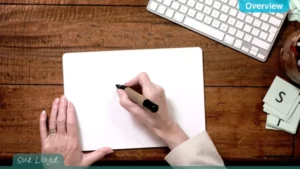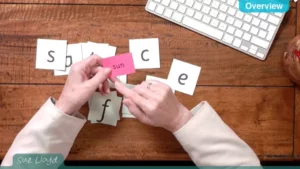Part 2 – Simple overview of the English alphabetic code
Part 2 – Simple overview of the English alphabetic code
Reasons are given for choosing the order the letter sounds are taught in, as well as an explanation of what makes the English alphabetic code so complicated.
Transcript
Print TranscriptPart 2: A simple overview of the English alphabetic code
Naturally, a programme has to have an order for introducing the letter sounds. The order itself is not particularly significant: It really does not matter if the /g/ sound is taught before the /b/ sound or if /i/ comes before /a/, so long as the children learn them and also learn how to use them for reading and writing words. This is the order we chose for the first four groups in Jolly Phonics:
Group 1: s a t i p n
Group 2: c k e h r m d
Group 3: g o u l f b
Group 4: ai j oa ie ee or
Our reasons for choosing this order were as follows:
- With the first group of six letter sounds you can make the most words, and that was what we wanted to do: to have plenty of words with which the children could practise the skill of blending.
- We introduced the caterpillar /c/ early on so that its shape would help with learning those letter sounds that start in a similar way, such as /d/, /o/, /g/ and /a/.
- We kept the sounds /d/ and /b/ in separate groups because children often muddle them up.
- And in Group 4, the /ai/, /oa/, /ie/, /ee/ and /or/ sounds are all digraphs: that is, two letters that represent one sound.
We deliberately introduced digraphs before we had finished the single letter sounds because we wanted to say that the digraphs were just as important as the single letter sounds. People often say they teach phonics but miss out the digraphs. This is like giving the children half a code and expecting them to work out the rest for themselves. Some of the children will still manage to succeed, but others will struggle and they often fail.
Digraphs would not be so awkward if only one way was used to represent each sound, but in English there are frequently many ways. For example, there are three common ways of spelling /ai/, which are taught in Steps 2 to 5:
- ‹ai›: as in rain, hail and laid (Step 2)
- ‹a_e›: as in name, cake and plate (Step 4). This is also known as an
‹a›-hop-over-‹e› digraph, a split digraph or as having a magic ‹e› - ‹ay›: as in day, way and play (Step 5)
However, as if that were not enough, there are even more alternative spellings than these, but in reality there are far fewer words that use them. Some of these more unusual spellings are covered in Step 6:
- ‹a›: as in apron, angel and change
- ‹ei›: as in feint, vein and veil
- ‹ey›: as in they, grey and obey
- ‹eigh›: as in eight, neigh and sleigh
- ‹et›: as in ballet, sorbet and buffet
- ‹ea›: as in great, break and steak (This is only used in a small number of /ai/ words. It usually makes the /ee/ sound, as in heat and dream)
- ‹aigh›: as in straight (as far as I know, this is the only word with this spelling)
So you can see that the English alphabetic code is complicated, which is why we start in a simple way and gradually introduce children to the more complex aspects of the code. As each new letter sound is taught, more words become available for reading and writing. These words are available along with a number of other free materials in the Resources section on the home page. They can also be found by scrolling down to the bottom of the screen in each step for teaching reading and writing.
Words are in squares for the children to use for blending practice. They are in the same order that is used for teaching the letter sounds. As each new letter sound is taught more words that use the new letter sound, and the previously taught ones, become available.
Words are in squares for the children to use for blending practice. They are in the same order that is used for teaching the letter sounds. As each new letter sound is taught more words that use the new letter sound, and the previously taught ones, become available.
Lists of words are downloadable, in the order that is used for teaching the letter sounds. This is useful for teachers who would like to prepare their own materials.
English alphabetic-code charts are particularly useful for adults who are interested in the many alternative spellings that are used in the English code.
This provides a simple guide to the letter sounds that are taught in Steps 1 - 5
Words are in squares for the children to use for blending practice. They are in the same order that is used for teaching the letter sounds. As each new letter sound is taught more words that use the new letter sound, and the previously taught ones, become available.
Words are in squares for the children to use for blending practice. They are in the same order that is used for teaching the letter sounds. As each new letter sound is taught more words that use the new letter sound, and the previously taught ones, become available.
Lists of words are downloadable, in the order that is used for teaching the letter sounds. This is useful for teachers who would like to prepare their own materials.
English alphabetic-code charts are particularly useful for adults who are interested in the many alternative spellings that are used in the English code.
This chart provides a simple overview of the teaching in Steps 1 - 6.

